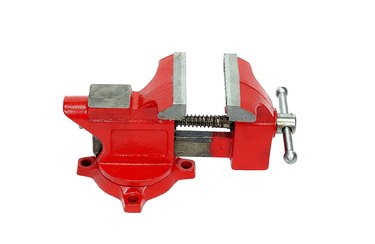Things You'll Need
Microfiber cloth
Solvent
Fine grit sandpaper
Plastic epoxy
Plastic knife
Vice clamp

Fiberglass and plastic are two commonly used building materials in commercial and industrial trades. Both of these materials mold to nearly any shape and size, allowing for use in automobile construction, building infrastructure and plumbing networks. Mixed media artists may also adopt fiberglass and plastics when crafting permanent sculptures. Bonding these two materials requires a high-strength plastic epoxy which is available at any hardware store.
Step 1
Clean the bonding surface on both the fiberglass and the plastic using a microfiber cloth dampened with a solvent. Isopropyl alcohol, acetone or lighter fluid are all acceptable options.
Video of the Day
Step 2
Roughen both of the surfaces slightly using a pad of fine grit sandpaper. This allows the epoxy to adhere better to both materials, resulting in a durable, lasting bond.
Step 3
Open your container of epoxy and mix according to the instructions printed on the container. Though some epoxies arrive ready for use, most manufacturers require you to mix the resin and hardener prior to application.
Step 4
Apply a thin, even coat of epoxy to each surface. Avoid applying too much epoxy, as this will result in a weaker bond.
Step 5
Press the fiberglass and plastic together and hold them in place for two to three minutes. Wipe away any excess epoxy using a damp cloth.
Step 6
Place the bonded pieces in a vice clamp. Tighten the clamps around the pieces by rotating the vice's arm clockwise. Do not apply too much pressure to the pieces, as it may cause them to crack.
Step 7
Allow the pieces to sit undisturbed in the clamp until the epoxy has cured. Refer to the recommended drying time on the container of epoxy for best results.
Tip
Most epoxies are thermosetting, meaning that curing time can be hastened through application of heat. Warm air from a blow dryer or exposure under a heat lamp may be used if fast curing is critical. Work in a well-lit, ventilated area.
Warning
Avoid any and all skin contact with the epoxy. Do not inhale fumes from the epoxy. Keep children and pets away from your work area.
Video of the Day